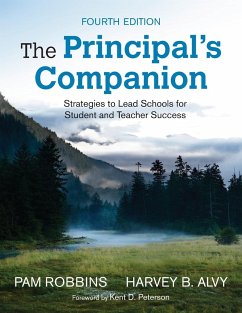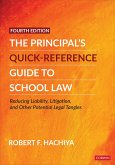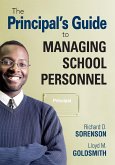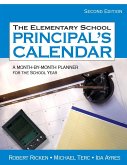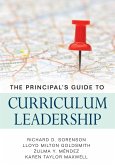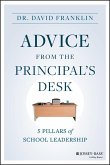Pam Robbins, Harvey B. Alvy
The Principal's Companion
Strategies to Lead Schools for Student and Teacher Success
Pam Robbins, Harvey B. Alvy
The Principal's Companion
Strategies to Lead Schools for Student and Teacher Success
- Broschiertes Buch
- Merkliste
- Auf die Merkliste
- Bewerten Bewerten
- Teilen
- Produkt teilen
- Produkterinnerung
- Produkterinnerung
Provides the practical resources and tools to help inservice and aspiring administrators manage the challenges of leading a learning organization and facilitating school improvement.
Andere Kunden interessierten sich auch für
![The Principal's Quick-Reference Guide to School Law The Principal's Quick-Reference Guide to School Law]() Robert F. Hachiya (USA Kansas State University)The Principal's Quick-Reference Guide to School Law59,99 €
Robert F. Hachiya (USA Kansas State University)The Principal's Quick-Reference Guide to School Law59,99 €![The Principal's Guide to Managing School Personnel The Principal's Guide to Managing School Personnel]() Richard D. SorensonThe Principal's Guide to Managing School Personnel43,99 €
Richard D. SorensonThe Principal's Guide to Managing School Personnel43,99 €![The Elementary School Principal's Calendar The Elementary School Principal's Calendar]() Robert RickenThe Elementary School Principal's Calendar49,99 €
Robert RickenThe Elementary School Principal's Calendar49,99 €![The Principal's Guide to Curriculum Leadership The Principal's Guide to Curriculum Leadership]() Richard D. SorensonThe Principal's Guide to Curriculum Leadership50,99 €
Richard D. SorensonThe Principal's Guide to Curriculum Leadership50,99 €![The Principal's Special Education Calendar The Principal's Special Education Calendar]() Joanne W. LaneThe Principal's Special Education Calendar28,99 €
Joanne W. LaneThe Principal's Special Education Calendar28,99 €![Knucklehead Fred and the Principal's Challenge Knucklehead Fred and the Principal's Challenge]() Arias WilliamsKnucklehead Fred and the Principal's Challenge25,99 €
Arias WilliamsKnucklehead Fred and the Principal's Challenge25,99 €![Advice from the Principal's Desk Advice from the Principal's Desk]() David Franklin (East Bay California State University)Advice from the Principal's Desk26,99 €
David Franklin (East Bay California State University)Advice from the Principal's Desk26,99 €-
-
-
Provides the practical resources and tools to help inservice and aspiring administrators manage the challenges of leading a learning organization and facilitating school improvement.
Hinweis: Dieser Artikel kann nur an eine deutsche Lieferadresse ausgeliefert werden.
Hinweis: Dieser Artikel kann nur an eine deutsche Lieferadresse ausgeliefert werden.
Produktdetails
- Produktdetails
- Verlag: SAGE Publications Inc
- 4 Revised edition
- Seitenzahl: 408
- Erscheinungstermin: 6. März 2014
- Englisch
- Abmessung: 280mm x 216mm x 22mm
- Gewicht: 1032g
- ISBN-13: 9781452287591
- ISBN-10: 1452287597
- Artikelnr.: 40032165
- Herstellerkennzeichnung
- Libri GmbH
- Europaallee 1
- 36244 Bad Hersfeld
- gpsr@libri.de
- Verlag: SAGE Publications Inc
- 4 Revised edition
- Seitenzahl: 408
- Erscheinungstermin: 6. März 2014
- Englisch
- Abmessung: 280mm x 216mm x 22mm
- Gewicht: 1032g
- ISBN-13: 9781452287591
- ISBN-10: 1452287597
- Artikelnr.: 40032165
- Herstellerkennzeichnung
- Libri GmbH
- Europaallee 1
- 36244 Bad Hersfeld
- gpsr@libri.de
Pam Robbins earned her doctorate in educational administration from the University of California, Berkeley. Currently, she consults with school systems, professional organizations, State Departments of Education, leadership academies, and corporations throughout the United States, Canada, Great Britain, Europe, Asia, and South America. Her presentation topics include professional learning communities, effective teaching, how the brain learns, emotional intelligence, leadership, teaching in the block schedule, peer coaching, school culture, and presentation skills. Pam has served as a teacher, high school basketball coach, administrator, director of special projects and research, and director of training for the North Bay California Leadership Academy. She has lectured at several universities, authored and co-authored books, and developed training materials for several principals′ academies. Harvey Alvy served in the principalship for more than a decade in both elementary and secondary schools. Harvey′s international experiences have taken him from the American School in Kinshasa, Zaire, to the American International School in Israel, the American Embassy School in New Delhi, India and Singapore American School. He was selected as an NAESP National Distinguished Principal for American Overseas Schools and is a founding member of the Principals′ Training Center for International Schools. In 2004 Harvey received the Eastern Washington University (EWU) CenturyTel Faculty Achievement Award for Teaching Excellence. He has co-authored, with Pam Robbins, Learning from Lincoln: Leadership Practices for School Success, The New Principal′s Fieldbook: Strategies for Success, The Principal′s Companionand If I Only Knew: Success Strategies for Navigating the Principalship. With Dr. Jane Liu, Harvey co-authored a Mandarin only book for Chinese school leaders, The Principal Management Handbook: The American Principal′s Approach to Successful Administration. He has conducted seminars, workshops, and presentations, both nationally and internationally on the newcomer to the principalship, educational trends, instructional leadership, moral leadership, characteristics of great teachers, and the leadership of Abraham Lincoln. Harvey holds the William C. Shreeve Endowed Professorship in Educational Leadership at EWU.
Foreword - Kent D. Peterson Preface Acknowledgments About the Authors Part I. The Principal
s Many Roles 1. Leader as Learner Principal as Lifelong Learner Learning in Many Contexts The Expanding Role of the Principal A Global Perspective When Old and New Ideas Converge Reflections 2. Leader as Manager Instructional Leadership Requires Effective Management Management Responsibilities and Strategies Crisis Management Planning A Final Observation Regarding School Management Reflections 3. Leader as Shaper of School Culture Core Values and Beliefs Are the Heart of Culture The Physical Environment Reflects Core Values: Portraits of Practice Rituals Display Core Values and Call Attention to What Is Important Celebrations Call Attention to What Is Important How People Spend Time Reflects Core Values Norms Are the Unwritten Rules of Culture Powerful Stories Communicate and Reinforce Cultural Values Reading, Transforming, or Shaping a Culture Final Thoughts on Culture Reflections Part II. Critical Skills for Effective Leadership 4. The Art of Human Relations: Getting the Job Done Task and Relationship Behaviors Differentiated Support Personality Styles Recommendations for Skillful Human Relations The Role of Emotions in the Organization: Remembering the Heart Reflections 5. Managing Time: Leading With Purpose Brevity, Fragmentation, and Variety Techniques for Time Management Managing Bifocally Multitasking: A Modern-Day Solution or Hazard? Final Thoughts on Using Time Reflections 6. Effectively Working With the Central Office: Coordinating Teaching, Learning, and Professional Development Caught in the Middle How Is the School District Governed? Communication Between the Schools and the Central Office The District Office as a Teaching and Learning Center The District Office and Principal Evaluations: Partnering for Success Management Tips for Working With the Central Office Maintaining a Strong Relationship Between the Central Office and the School Forging a School and Central Office Partnership: Putting Staff and Student Learning First Reflections Part III. Honoring the School
s Mission 7. Understanding, Planning, and Implementing Change Guiding the Change Journey: Three Questions Understanding Change Change Brings Loss and Resistance Change Influences Individuals and the Organization Failure, Risk-Taking, and Conflict: Ingredients for Change Strategies to Promote Trust Classical Insights Regarding Change and Continuous Improvement Three Phases of Change A Look at Change From the Individual
s Perspective Stages of Concern Some Final Thoughts on Change Reflections 8. Building a Vision and a Mission Together Reflecting on Vision and Mission Why Have a Shared School Vision and Mission? School Activities That Highlight the Mission Mission-Building Activity Developing Yearly School Improvement Goals to Accomplish the Mission Reflections Part IV. Working Together to Build a Learning Community 9. Enhancing Teacher Growth Through Supervision and Evaluation Practices Designed to Promote Student Learning Issues and Dilemmas Essential Ingredients for Successful Supervision Effective Instructional Strategies Brain-Compatible Teaching Practices Guidelines to Successfully Navigate Through Required State and District Teacher Evaluations Frameworks Increasing Teacher and Administrative Understanding Through Reflective Clinical Supervision Tips for Conferencing and Observing Walk-Throughs, Instructional Rounds, Snapshots, or Drive-Bys Guidelines Related to Evaluation and Legal Concerns Final Thoughts on Supervision and Evaluation Reflections 10. Maximizing Feedback About Teaching: Differentiated Professional Growth Options Reflections on Feedback Creating the Environment for Maximizing Feedback Building a Foundation: Getting Started Moving Toward Collaborative Feedback Differentiated Professional Growth Options: How the System Works Sources of Feedback: Categories and Approaches Self-Assessment: Establishing Benchmarks of Progress Individual Reflection and Institutional Renewal Reflections 11. Building a Collaborative School: The Power of Teacher Leadership and Community Portrait of a Collaborative School: A Professional Learning Community An Image of Reality: Obstacles to Collaboration The Case for Collaboration Moving Toward Collaboration Necessary Conditions for a Collaborative School Teacher Leadership and the Collaborative School The Principal and Collaboration Some Final Thoughts on Collaboration Reflections 12. Fueling the Learning Organization Through Professional Development Why Professional Development? Professional Development Defined Standards for Professional Learning Creating a Context Where Professional Learning Thrives: Some Guidelines Leadership Teams and Professional Learning Optimizing the Individual
s Professional Learning Experience Central Office Support for Professional Learning Final Thoughts on Professional Learning Reflections 13. Faculty Meetings: A Tool for Capacity Building Faculty Meetings as Learning Opportunities--Getting Started The School Mission and Faculty Meetings Increasing Teachers
Roles in Faculty Meetings Some Successful Faculty Meeting Strategies: Stories of Practice Faculty Meeting Strategies That Work! A Final Thought Reflections 14. Asking the Right Questions About Curriculum, Instruction, and Assessment: Getting to Know the C.I.A. We Live in Interesting Times Asking the Right Questions Continuing the Curriculum Discussion Reflections Part V. Starting Effectively and Staying the Course 15. First Days of School Logistical Concerns Beginning-of-the-Year Faculty Meetings Set a Tone Departmental and Grade-Level Meetings Orienting Teachers Who Are New to the School Teacher Time in the Classroom Welcoming Students and Parents Be Visible on the First Days of School Reflections 16. Tips: Ideas That Work and Align With the School
s Mission Organizing Your Time Additional Helpful Ideas to Stay On Task Tips From a Superintendent: What Makes a Successful 21st Century Principal The School Budget: Common Sense Efficiency Tips Based on the Mission Providing Experiences to Celebrate the School
s Culture Tips on Opening a New School Tips on Using Technology to Enhance a Principal
s Performance Using Tips in Your Setting Reflections Part VI. Embracing Your Constituencies 17. Working With Parents and Partnering With the Greater Community Effectively Communicating With Parents Building Bridges With the Parent Community Additional Ways to Bring Parents and Community Members Into School Broadening School Support and Partnerships Community-Based Organizations Seeking School Support Through Educational Grants Reaching Out and Working With the Media A Reflection on Partnering With Parents and the Community Reflections 18. Making a Difference for Students: The Heart of the School The Challenge of Excellence and Equality, Social Justice, and School Leadership "Those Kids" and Their Stories The Right to Be a Child and to Make Mistakes Maximizing Opportunities for Students With Disabilities Response to Intervention (RTI) School Discipline: The Principal
s Role, the Discipline Gap, and Promising Options Broad Disciplinary Guidelines Reducing Bullying Behavior Cyberbullying and Social Responsibility Supporting Lesbian, Gay, Bisexual, and Transgender Youth Graduating Americäs Youth: Making Progress on a Long Road Student and Teacher Resiliency Final Thoughts on "Those Kids" Reflections VII. The Principal
s Professional and Personal Worlds 19. The Newcomer to the Principalship Problems That Challenge New Principals A Profile of the New Principal Helping Prospective and New Principals Make the Grade Practical Suggestions for Newcomers Final Thoughts on the Newcomer Experience Reflections 20. Taking Care of Yourself Achieving Success Over Stress Taking Control of Time Towards Realizing the Vision: A Personal Mission Statement Gaining Perspective by Spending Time With Students Body and Mind: Healthy and Ill Together Reflections 21. Keeping the Professional Candle Lit Institutionalizing Professional Learning Reflection as a Tool A Principal
s Portfolio Other Growth Opportunities Reflections 22. Reflections on the Principalship Serving the School Community Where Do We Go From Here? The Good School Take Time to Smell the Roses Reflections References and Additional Readings Index
s Many Roles 1. Leader as Learner Principal as Lifelong Learner Learning in Many Contexts The Expanding Role of the Principal A Global Perspective When Old and New Ideas Converge Reflections 2. Leader as Manager Instructional Leadership Requires Effective Management Management Responsibilities and Strategies Crisis Management Planning A Final Observation Regarding School Management Reflections 3. Leader as Shaper of School Culture Core Values and Beliefs Are the Heart of Culture The Physical Environment Reflects Core Values: Portraits of Practice Rituals Display Core Values and Call Attention to What Is Important Celebrations Call Attention to What Is Important How People Spend Time Reflects Core Values Norms Are the Unwritten Rules of Culture Powerful Stories Communicate and Reinforce Cultural Values Reading, Transforming, or Shaping a Culture Final Thoughts on Culture Reflections Part II. Critical Skills for Effective Leadership 4. The Art of Human Relations: Getting the Job Done Task and Relationship Behaviors Differentiated Support Personality Styles Recommendations for Skillful Human Relations The Role of Emotions in the Organization: Remembering the Heart Reflections 5. Managing Time: Leading With Purpose Brevity, Fragmentation, and Variety Techniques for Time Management Managing Bifocally Multitasking: A Modern-Day Solution or Hazard? Final Thoughts on Using Time Reflections 6. Effectively Working With the Central Office: Coordinating Teaching, Learning, and Professional Development Caught in the Middle How Is the School District Governed? Communication Between the Schools and the Central Office The District Office as a Teaching and Learning Center The District Office and Principal Evaluations: Partnering for Success Management Tips for Working With the Central Office Maintaining a Strong Relationship Between the Central Office and the School Forging a School and Central Office Partnership: Putting Staff and Student Learning First Reflections Part III. Honoring the School
s Mission 7. Understanding, Planning, and Implementing Change Guiding the Change Journey: Three Questions Understanding Change Change Brings Loss and Resistance Change Influences Individuals and the Organization Failure, Risk-Taking, and Conflict: Ingredients for Change Strategies to Promote Trust Classical Insights Regarding Change and Continuous Improvement Three Phases of Change A Look at Change From the Individual
s Perspective Stages of Concern Some Final Thoughts on Change Reflections 8. Building a Vision and a Mission Together Reflecting on Vision and Mission Why Have a Shared School Vision and Mission? School Activities That Highlight the Mission Mission-Building Activity Developing Yearly School Improvement Goals to Accomplish the Mission Reflections Part IV. Working Together to Build a Learning Community 9. Enhancing Teacher Growth Through Supervision and Evaluation Practices Designed to Promote Student Learning Issues and Dilemmas Essential Ingredients for Successful Supervision Effective Instructional Strategies Brain-Compatible Teaching Practices Guidelines to Successfully Navigate Through Required State and District Teacher Evaluations Frameworks Increasing Teacher and Administrative Understanding Through Reflective Clinical Supervision Tips for Conferencing and Observing Walk-Throughs, Instructional Rounds, Snapshots, or Drive-Bys Guidelines Related to Evaluation and Legal Concerns Final Thoughts on Supervision and Evaluation Reflections 10. Maximizing Feedback About Teaching: Differentiated Professional Growth Options Reflections on Feedback Creating the Environment for Maximizing Feedback Building a Foundation: Getting Started Moving Toward Collaborative Feedback Differentiated Professional Growth Options: How the System Works Sources of Feedback: Categories and Approaches Self-Assessment: Establishing Benchmarks of Progress Individual Reflection and Institutional Renewal Reflections 11. Building a Collaborative School: The Power of Teacher Leadership and Community Portrait of a Collaborative School: A Professional Learning Community An Image of Reality: Obstacles to Collaboration The Case for Collaboration Moving Toward Collaboration Necessary Conditions for a Collaborative School Teacher Leadership and the Collaborative School The Principal and Collaboration Some Final Thoughts on Collaboration Reflections 12. Fueling the Learning Organization Through Professional Development Why Professional Development? Professional Development Defined Standards for Professional Learning Creating a Context Where Professional Learning Thrives: Some Guidelines Leadership Teams and Professional Learning Optimizing the Individual
s Professional Learning Experience Central Office Support for Professional Learning Final Thoughts on Professional Learning Reflections 13. Faculty Meetings: A Tool for Capacity Building Faculty Meetings as Learning Opportunities--Getting Started The School Mission and Faculty Meetings Increasing Teachers
Roles in Faculty Meetings Some Successful Faculty Meeting Strategies: Stories of Practice Faculty Meeting Strategies That Work! A Final Thought Reflections 14. Asking the Right Questions About Curriculum, Instruction, and Assessment: Getting to Know the C.I.A. We Live in Interesting Times Asking the Right Questions Continuing the Curriculum Discussion Reflections Part V. Starting Effectively and Staying the Course 15. First Days of School Logistical Concerns Beginning-of-the-Year Faculty Meetings Set a Tone Departmental and Grade-Level Meetings Orienting Teachers Who Are New to the School Teacher Time in the Classroom Welcoming Students and Parents Be Visible on the First Days of School Reflections 16. Tips: Ideas That Work and Align With the School
s Mission Organizing Your Time Additional Helpful Ideas to Stay On Task Tips From a Superintendent: What Makes a Successful 21st Century Principal The School Budget: Common Sense Efficiency Tips Based on the Mission Providing Experiences to Celebrate the School
s Culture Tips on Opening a New School Tips on Using Technology to Enhance a Principal
s Performance Using Tips in Your Setting Reflections Part VI. Embracing Your Constituencies 17. Working With Parents and Partnering With the Greater Community Effectively Communicating With Parents Building Bridges With the Parent Community Additional Ways to Bring Parents and Community Members Into School Broadening School Support and Partnerships Community-Based Organizations Seeking School Support Through Educational Grants Reaching Out and Working With the Media A Reflection on Partnering With Parents and the Community Reflections 18. Making a Difference for Students: The Heart of the School The Challenge of Excellence and Equality, Social Justice, and School Leadership "Those Kids" and Their Stories The Right to Be a Child and to Make Mistakes Maximizing Opportunities for Students With Disabilities Response to Intervention (RTI) School Discipline: The Principal
s Role, the Discipline Gap, and Promising Options Broad Disciplinary Guidelines Reducing Bullying Behavior Cyberbullying and Social Responsibility Supporting Lesbian, Gay, Bisexual, and Transgender Youth Graduating Americäs Youth: Making Progress on a Long Road Student and Teacher Resiliency Final Thoughts on "Those Kids" Reflections VII. The Principal
s Professional and Personal Worlds 19. The Newcomer to the Principalship Problems That Challenge New Principals A Profile of the New Principal Helping Prospective and New Principals Make the Grade Practical Suggestions for Newcomers Final Thoughts on the Newcomer Experience Reflections 20. Taking Care of Yourself Achieving Success Over Stress Taking Control of Time Towards Realizing the Vision: A Personal Mission Statement Gaining Perspective by Spending Time With Students Body and Mind: Healthy and Ill Together Reflections 21. Keeping the Professional Candle Lit Institutionalizing Professional Learning Reflection as a Tool A Principal
s Portfolio Other Growth Opportunities Reflections 22. Reflections on the Principalship Serving the School Community Where Do We Go From Here? The Good School Take Time to Smell the Roses Reflections References and Additional Readings Index
Foreword - Kent D. Peterson Preface Acknowledgments About the Authors Part I. The Principal
s Many Roles 1. Leader as Learner Principal as Lifelong Learner Learning in Many Contexts The Expanding Role of the Principal A Global Perspective When Old and New Ideas Converge Reflections 2. Leader as Manager Instructional Leadership Requires Effective Management Management Responsibilities and Strategies Crisis Management Planning A Final Observation Regarding School Management Reflections 3. Leader as Shaper of School Culture Core Values and Beliefs Are the Heart of Culture The Physical Environment Reflects Core Values: Portraits of Practice Rituals Display Core Values and Call Attention to What Is Important Celebrations Call Attention to What Is Important How People Spend Time Reflects Core Values Norms Are the Unwritten Rules of Culture Powerful Stories Communicate and Reinforce Cultural Values Reading, Transforming, or Shaping a Culture Final Thoughts on Culture Reflections Part II. Critical Skills for Effective Leadership 4. The Art of Human Relations: Getting the Job Done Task and Relationship Behaviors Differentiated Support Personality Styles Recommendations for Skillful Human Relations The Role of Emotions in the Organization: Remembering the Heart Reflections 5. Managing Time: Leading With Purpose Brevity, Fragmentation, and Variety Techniques for Time Management Managing Bifocally Multitasking: A Modern-Day Solution or Hazard? Final Thoughts on Using Time Reflections 6. Effectively Working With the Central Office: Coordinating Teaching, Learning, and Professional Development Caught in the Middle How Is the School District Governed? Communication Between the Schools and the Central Office The District Office as a Teaching and Learning Center The District Office and Principal Evaluations: Partnering for Success Management Tips for Working With the Central Office Maintaining a Strong Relationship Between the Central Office and the School Forging a School and Central Office Partnership: Putting Staff and Student Learning First Reflections Part III. Honoring the School
s Mission 7. Understanding, Planning, and Implementing Change Guiding the Change Journey: Three Questions Understanding Change Change Brings Loss and Resistance Change Influences Individuals and the Organization Failure, Risk-Taking, and Conflict: Ingredients for Change Strategies to Promote Trust Classical Insights Regarding Change and Continuous Improvement Three Phases of Change A Look at Change From the Individual
s Perspective Stages of Concern Some Final Thoughts on Change Reflections 8. Building a Vision and a Mission Together Reflecting on Vision and Mission Why Have a Shared School Vision and Mission? School Activities That Highlight the Mission Mission-Building Activity Developing Yearly School Improvement Goals to Accomplish the Mission Reflections Part IV. Working Together to Build a Learning Community 9. Enhancing Teacher Growth Through Supervision and Evaluation Practices Designed to Promote Student Learning Issues and Dilemmas Essential Ingredients for Successful Supervision Effective Instructional Strategies Brain-Compatible Teaching Practices Guidelines to Successfully Navigate Through Required State and District Teacher Evaluations Frameworks Increasing Teacher and Administrative Understanding Through Reflective Clinical Supervision Tips for Conferencing and Observing Walk-Throughs, Instructional Rounds, Snapshots, or Drive-Bys Guidelines Related to Evaluation and Legal Concerns Final Thoughts on Supervision and Evaluation Reflections 10. Maximizing Feedback About Teaching: Differentiated Professional Growth Options Reflections on Feedback Creating the Environment for Maximizing Feedback Building a Foundation: Getting Started Moving Toward Collaborative Feedback Differentiated Professional Growth Options: How the System Works Sources of Feedback: Categories and Approaches Self-Assessment: Establishing Benchmarks of Progress Individual Reflection and Institutional Renewal Reflections 11. Building a Collaborative School: The Power of Teacher Leadership and Community Portrait of a Collaborative School: A Professional Learning Community An Image of Reality: Obstacles to Collaboration The Case for Collaboration Moving Toward Collaboration Necessary Conditions for a Collaborative School Teacher Leadership and the Collaborative School The Principal and Collaboration Some Final Thoughts on Collaboration Reflections 12. Fueling the Learning Organization Through Professional Development Why Professional Development? Professional Development Defined Standards for Professional Learning Creating a Context Where Professional Learning Thrives: Some Guidelines Leadership Teams and Professional Learning Optimizing the Individual
s Professional Learning Experience Central Office Support for Professional Learning Final Thoughts on Professional Learning Reflections 13. Faculty Meetings: A Tool for Capacity Building Faculty Meetings as Learning Opportunities--Getting Started The School Mission and Faculty Meetings Increasing Teachers
Roles in Faculty Meetings Some Successful Faculty Meeting Strategies: Stories of Practice Faculty Meeting Strategies That Work! A Final Thought Reflections 14. Asking the Right Questions About Curriculum, Instruction, and Assessment: Getting to Know the C.I.A. We Live in Interesting Times Asking the Right Questions Continuing the Curriculum Discussion Reflections Part V. Starting Effectively and Staying the Course 15. First Days of School Logistical Concerns Beginning-of-the-Year Faculty Meetings Set a Tone Departmental and Grade-Level Meetings Orienting Teachers Who Are New to the School Teacher Time in the Classroom Welcoming Students and Parents Be Visible on the First Days of School Reflections 16. Tips: Ideas That Work and Align With the School
s Mission Organizing Your Time Additional Helpful Ideas to Stay On Task Tips From a Superintendent: What Makes a Successful 21st Century Principal The School Budget: Common Sense Efficiency Tips Based on the Mission Providing Experiences to Celebrate the School
s Culture Tips on Opening a New School Tips on Using Technology to Enhance a Principal
s Performance Using Tips in Your Setting Reflections Part VI. Embracing Your Constituencies 17. Working With Parents and Partnering With the Greater Community Effectively Communicating With Parents Building Bridges With the Parent Community Additional Ways to Bring Parents and Community Members Into School Broadening School Support and Partnerships Community-Based Organizations Seeking School Support Through Educational Grants Reaching Out and Working With the Media A Reflection on Partnering With Parents and the Community Reflections 18. Making a Difference for Students: The Heart of the School The Challenge of Excellence and Equality, Social Justice, and School Leadership "Those Kids" and Their Stories The Right to Be a Child and to Make Mistakes Maximizing Opportunities for Students With Disabilities Response to Intervention (RTI) School Discipline: The Principal
s Role, the Discipline Gap, and Promising Options Broad Disciplinary Guidelines Reducing Bullying Behavior Cyberbullying and Social Responsibility Supporting Lesbian, Gay, Bisexual, and Transgender Youth Graduating Americäs Youth: Making Progress on a Long Road Student and Teacher Resiliency Final Thoughts on "Those Kids" Reflections VII. The Principal
s Professional and Personal Worlds 19. The Newcomer to the Principalship Problems That Challenge New Principals A Profile of the New Principal Helping Prospective and New Principals Make the Grade Practical Suggestions for Newcomers Final Thoughts on the Newcomer Experience Reflections 20. Taking Care of Yourself Achieving Success Over Stress Taking Control of Time Towards Realizing the Vision: A Personal Mission Statement Gaining Perspective by Spending Time With Students Body and Mind: Healthy and Ill Together Reflections 21. Keeping the Professional Candle Lit Institutionalizing Professional Learning Reflection as a Tool A Principal
s Portfolio Other Growth Opportunities Reflections 22. Reflections on the Principalship Serving the School Community Where Do We Go From Here? The Good School Take Time to Smell the Roses Reflections References and Additional Readings Index
s Many Roles 1. Leader as Learner Principal as Lifelong Learner Learning in Many Contexts The Expanding Role of the Principal A Global Perspective When Old and New Ideas Converge Reflections 2. Leader as Manager Instructional Leadership Requires Effective Management Management Responsibilities and Strategies Crisis Management Planning A Final Observation Regarding School Management Reflections 3. Leader as Shaper of School Culture Core Values and Beliefs Are the Heart of Culture The Physical Environment Reflects Core Values: Portraits of Practice Rituals Display Core Values and Call Attention to What Is Important Celebrations Call Attention to What Is Important How People Spend Time Reflects Core Values Norms Are the Unwritten Rules of Culture Powerful Stories Communicate and Reinforce Cultural Values Reading, Transforming, or Shaping a Culture Final Thoughts on Culture Reflections Part II. Critical Skills for Effective Leadership 4. The Art of Human Relations: Getting the Job Done Task and Relationship Behaviors Differentiated Support Personality Styles Recommendations for Skillful Human Relations The Role of Emotions in the Organization: Remembering the Heart Reflections 5. Managing Time: Leading With Purpose Brevity, Fragmentation, and Variety Techniques for Time Management Managing Bifocally Multitasking: A Modern-Day Solution or Hazard? Final Thoughts on Using Time Reflections 6. Effectively Working With the Central Office: Coordinating Teaching, Learning, and Professional Development Caught in the Middle How Is the School District Governed? Communication Between the Schools and the Central Office The District Office as a Teaching and Learning Center The District Office and Principal Evaluations: Partnering for Success Management Tips for Working With the Central Office Maintaining a Strong Relationship Between the Central Office and the School Forging a School and Central Office Partnership: Putting Staff and Student Learning First Reflections Part III. Honoring the School
s Mission 7. Understanding, Planning, and Implementing Change Guiding the Change Journey: Three Questions Understanding Change Change Brings Loss and Resistance Change Influences Individuals and the Organization Failure, Risk-Taking, and Conflict: Ingredients for Change Strategies to Promote Trust Classical Insights Regarding Change and Continuous Improvement Three Phases of Change A Look at Change From the Individual
s Perspective Stages of Concern Some Final Thoughts on Change Reflections 8. Building a Vision and a Mission Together Reflecting on Vision and Mission Why Have a Shared School Vision and Mission? School Activities That Highlight the Mission Mission-Building Activity Developing Yearly School Improvement Goals to Accomplish the Mission Reflections Part IV. Working Together to Build a Learning Community 9. Enhancing Teacher Growth Through Supervision and Evaluation Practices Designed to Promote Student Learning Issues and Dilemmas Essential Ingredients for Successful Supervision Effective Instructional Strategies Brain-Compatible Teaching Practices Guidelines to Successfully Navigate Through Required State and District Teacher Evaluations Frameworks Increasing Teacher and Administrative Understanding Through Reflective Clinical Supervision Tips for Conferencing and Observing Walk-Throughs, Instructional Rounds, Snapshots, or Drive-Bys Guidelines Related to Evaluation and Legal Concerns Final Thoughts on Supervision and Evaluation Reflections 10. Maximizing Feedback About Teaching: Differentiated Professional Growth Options Reflections on Feedback Creating the Environment for Maximizing Feedback Building a Foundation: Getting Started Moving Toward Collaborative Feedback Differentiated Professional Growth Options: How the System Works Sources of Feedback: Categories and Approaches Self-Assessment: Establishing Benchmarks of Progress Individual Reflection and Institutional Renewal Reflections 11. Building a Collaborative School: The Power of Teacher Leadership and Community Portrait of a Collaborative School: A Professional Learning Community An Image of Reality: Obstacles to Collaboration The Case for Collaboration Moving Toward Collaboration Necessary Conditions for a Collaborative School Teacher Leadership and the Collaborative School The Principal and Collaboration Some Final Thoughts on Collaboration Reflections 12. Fueling the Learning Organization Through Professional Development Why Professional Development? Professional Development Defined Standards for Professional Learning Creating a Context Where Professional Learning Thrives: Some Guidelines Leadership Teams and Professional Learning Optimizing the Individual
s Professional Learning Experience Central Office Support for Professional Learning Final Thoughts on Professional Learning Reflections 13. Faculty Meetings: A Tool for Capacity Building Faculty Meetings as Learning Opportunities--Getting Started The School Mission and Faculty Meetings Increasing Teachers
Roles in Faculty Meetings Some Successful Faculty Meeting Strategies: Stories of Practice Faculty Meeting Strategies That Work! A Final Thought Reflections 14. Asking the Right Questions About Curriculum, Instruction, and Assessment: Getting to Know the C.I.A. We Live in Interesting Times Asking the Right Questions Continuing the Curriculum Discussion Reflections Part V. Starting Effectively and Staying the Course 15. First Days of School Logistical Concerns Beginning-of-the-Year Faculty Meetings Set a Tone Departmental and Grade-Level Meetings Orienting Teachers Who Are New to the School Teacher Time in the Classroom Welcoming Students and Parents Be Visible on the First Days of School Reflections 16. Tips: Ideas That Work and Align With the School
s Mission Organizing Your Time Additional Helpful Ideas to Stay On Task Tips From a Superintendent: What Makes a Successful 21st Century Principal The School Budget: Common Sense Efficiency Tips Based on the Mission Providing Experiences to Celebrate the School
s Culture Tips on Opening a New School Tips on Using Technology to Enhance a Principal
s Performance Using Tips in Your Setting Reflections Part VI. Embracing Your Constituencies 17. Working With Parents and Partnering With the Greater Community Effectively Communicating With Parents Building Bridges With the Parent Community Additional Ways to Bring Parents and Community Members Into School Broadening School Support and Partnerships Community-Based Organizations Seeking School Support Through Educational Grants Reaching Out and Working With the Media A Reflection on Partnering With Parents and the Community Reflections 18. Making a Difference for Students: The Heart of the School The Challenge of Excellence and Equality, Social Justice, and School Leadership "Those Kids" and Their Stories The Right to Be a Child and to Make Mistakes Maximizing Opportunities for Students With Disabilities Response to Intervention (RTI) School Discipline: The Principal
s Role, the Discipline Gap, and Promising Options Broad Disciplinary Guidelines Reducing Bullying Behavior Cyberbullying and Social Responsibility Supporting Lesbian, Gay, Bisexual, and Transgender Youth Graduating Americäs Youth: Making Progress on a Long Road Student and Teacher Resiliency Final Thoughts on "Those Kids" Reflections VII. The Principal
s Professional and Personal Worlds 19. The Newcomer to the Principalship Problems That Challenge New Principals A Profile of the New Principal Helping Prospective and New Principals Make the Grade Practical Suggestions for Newcomers Final Thoughts on the Newcomer Experience Reflections 20. Taking Care of Yourself Achieving Success Over Stress Taking Control of Time Towards Realizing the Vision: A Personal Mission Statement Gaining Perspective by Spending Time With Students Body and Mind: Healthy and Ill Together Reflections 21. Keeping the Professional Candle Lit Institutionalizing Professional Learning Reflection as a Tool A Principal
s Portfolio Other Growth Opportunities Reflections 22. Reflections on the Principalship Serving the School Community Where Do We Go From Here? The Good School Take Time to Smell the Roses Reflections References and Additional Readings Index

